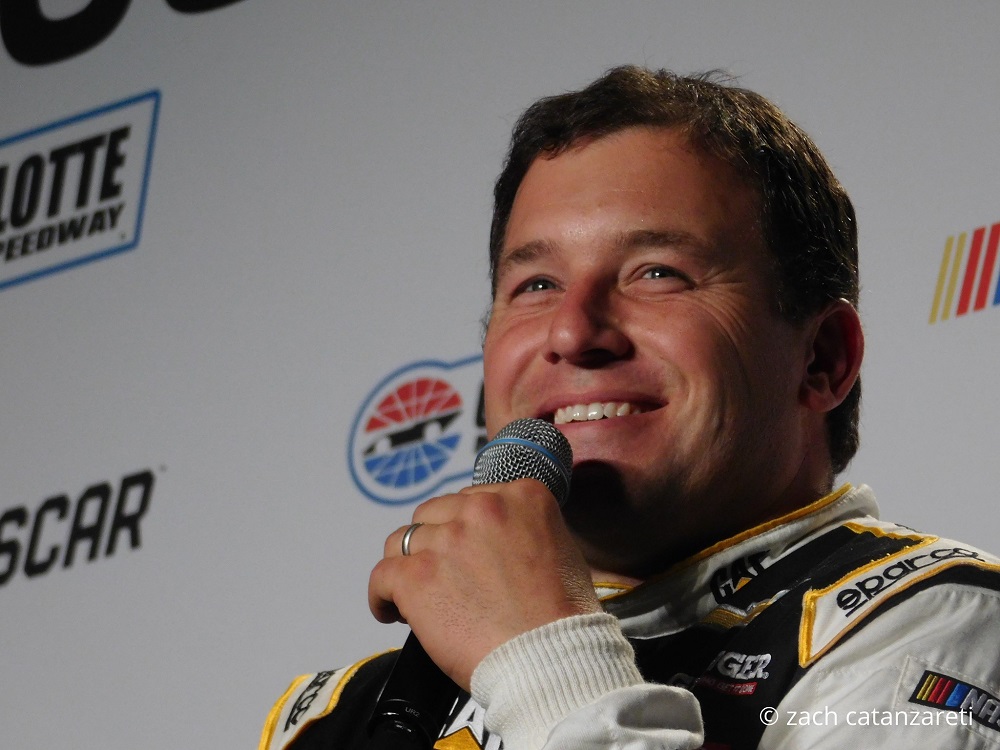
On Wednesday, a feat some viewed as miraculous happened: NASCAR driver Ryan Newman walked out of Halifax Medical Center less than 48 hours after a dramatic crash in the season-opening Daytona 500:
Best sight ever!!! https://t.co/g1G3VDwpi1 pic.twitter.com/kMs4u8LjOL
— Krissie Newman (@NewmanKrissie) February 19, 2020
On Monday evening, on the last lap of a rain-delayed race that originally began on Sunday, Newman’s car got turned by Ryan Blaney, whereupon it flipped over and was struck head-on by Corey Lajoie. The contact with Lajoie launched Newman’s car into the air, where it contacted the outside retaining wall and slid on its roof before coming (mercifully) to a stop upside-down.
NASCAR fans have seen many similar wrecks like these over the years, particularly on the sport’s two largest tracks: The Daytona International Speedway and Talladega Superspeedway. At these two superspeedways, NASCAR uses restrictions on engines—up until last year, restrictor plates on engine carburetors—and other aerodynamic rules that bunch cars up in large packs.
Ironically, NASCAR began using restrictor plates following a 1987 crash by driver Bobby Allison, who upon blowing a tire slammed into the metal catch-fencing at more than 200 miles per hour—and right in front of thousands of spectators. NASCAR, fearing that ever-climbing speeds at Talladega and Daytona meant drivers would lose control of their vehicles, demanded changes to slow the race pace.
But in slowing the cars, NASCAR also created the modern era of “pack racing,” where virtually the entire field of 40 cars race within a second or two of each other. These bunched-up fields all but guarantee that races at Daytona and Talladega will feature a “Big One”—a wreck where one spinning car collects dozens of others, turning the speedway into a de facto demolition derby. (In Monday’s race, contact between Aric Almirola and Brad Keselowski sparked a huge wreck with 17 laps remaining in the race; announcer Mike Joy responded, “Well, there goes half the field.”)
The close-pack racing makes big wrecks a fact of life in NASCAR, particularly at superspeedways. No one blamed Ryan Blaney for the contact that flipped Newman’s car, nor Lajoie for launching him airborne. Blaney was racing hard for the win on the last lap of NASCAR’s biggest race, and Lajoie had no time to react before hitting Newman. The incident was, as drivers are wont to claim, “Just one of them racin’ deals.”
Paradoxically, because big wrecks have become a part of superspeedway racing for more than three decades, drivers have a greater likelihood of surviving them. NASCAR has gone to great lengths to try and improve safety, often in the wake of prior incidents.
Rusty Wallace’s crash at Talladega in 1993 (from which he walked away) led the series to develop roof flaps, designed to deploy to keep cars from getting airborne when spinning. They have worked in many cases, but didn’t help much during Newman’s crash, because Lajoie’s vehicle punted Newman’s car into the air.
Following Dale Earnhardt’s tragic death on the last lap of the 2001 Daytona 500, NASCAR developed the head-and-neck support (HANS) device, designed to prevent basilar skull fractures. Prior to the HANS device, drivers’ seat belts would keep their bodies in their seats, but momentum would keep the head moving forward, causing the kind of brain trauma that killed Earnhardt (and others).
The Indianapolis Motor Speedway developed a Steel and Foam Energy Reduction (SAFER) barrier in 2002, designed to absorb and dissipate much of the impact from collisions, so that drivers do not plow directly into concrete walls. Its widespread adoption across NASCAR and other series does not make racing completely safe, but increases the likelihood of surviving incidents.
While NASCAR has not seen a fatality in its three national touring series since Earnhardt’s death in 2001, it does not mean racing does not have costs. Most notably, Earnhardt’s son and namesake retired to a role as a broadcaster after the 2017 season, in large part due to repeated concussions, and fear about the consequences should he suffer additional brain trauma. In 2016, Dale Earnhardt, Jr. pledged upon his death to donate his brain for concussion research.
For NASCAR, the Newman incident again raised the question of whether superspeedway racing at Daytona and Talladega—at which the likelihood of multi-car pileups approaches 100 percent—represents an acceptable risk to drivers and teams. Ironically enough, while the Daytona 500 represents the sport’s biggest race, the Daytona International Speedway also serves as NASCAR’s deadliest track, with eight of the 28 fatalities from the sport’s premier series coming on Daytona’s high banks.
NASCAR fans either love or hate superspeedway racing. Some love the drama, excitement, and close finishes, while others become jaded by the wreck-fests that inevitably result. And while some fans will cite Newman’s horrific incident as a wake-up call to re-evaluate superspeedway racing entirely, the fact that Dale Earnhardt, Sr.’s death failed to prompt such a re-evaluation suggests the Daytona and Talladega races will continue.
At minimum, however, the fact that Newman could survive his Daytona wreck shows the strides that NASCAR continues to make regarding driver safety, in a sport that all drivers admit brings inherent risk.
https://news.google.com/__i/rss/rd/articles/CBMiUWh0dHBzOi8vdGhlZmVkZXJhbGlzdC5jb20vMjAyMC8wMi8yMC93aHktcnlhbi1uZXdtYW4tY3Jhc2hlZC1hbmQtd2h5LWhlLXN1cnZpdmVkL9IBAA?oc=5
2020-02-20 12:05:38Z
52780620781314
Tidak ada komentar:
Posting Komentar